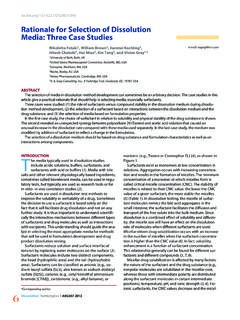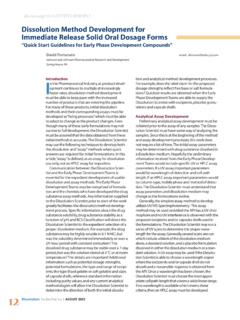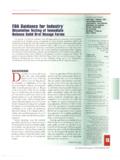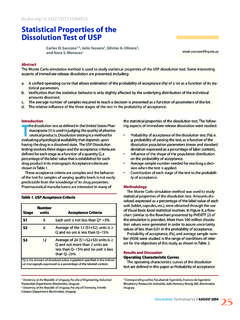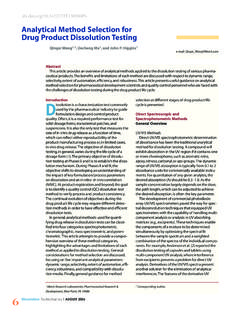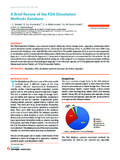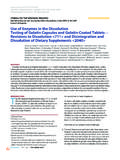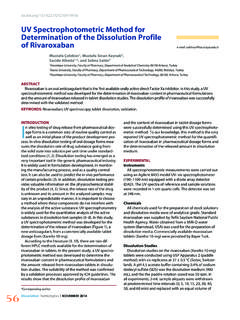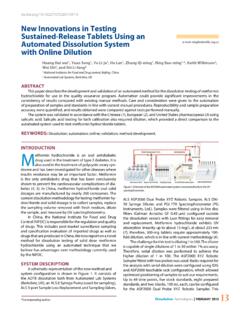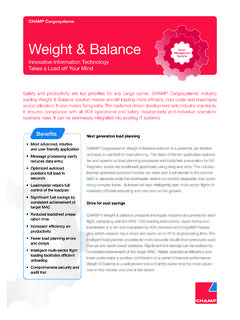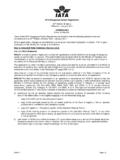Transcription of Instant FaSSIF and FeSSIF—Biorelevance
1 Dissolution Technologies | AUGUST 200941e-mail: FaSSIF and fessif biorelevance Meets PracticalityJulia Elisabeth Boni1,2, Rolf Stefan Brickl1, Jennifer Dressman2,3, and Martin L. Pfefferle11 Pharmaceutical Research & Development, Boehringer Ingelheim Pharma GmbH & Co. KG, Biberach an der Riss, Germany2 Institute of Pharmaceutical Technology, Johann Wolfgang Goethe University, Max-von-Laue Str. 9, 60438 Frankfurt am Main, GermanyABSTRACTThe objective of this study was to prepare an Instant form of FaSSIF and fessif that could be implemented easily and reproducibly in the laboratory setting. Concentrated solutions containing bile salts and lecithin were freeze-dried and further processed into bulk packs, blisters, or tablets, or sealed in powder form under nitrogen in vials. Physical properties as well as solubility and dissolution data for two poorly soluble compounds, danazol and a Boehringer-Ingelheim devel-opment compound (BIXX), were compared with data for freshly prepared FaSSIF and fessif and a commercially available Instant product.
2 After the freeze-dried FaSSIF and fessif media were reconstituted with appropriate buffers, their properties were close to those of freshly prepared media and a commercially available product for reconstitution, SIF Powder. Additionally, the solubility and dissolution profiles of danazol and BIXX in media prepared by all three methods were similar. Reconstitution of freeze-dried Instant FaSSIF and fessif appears to be an accurate, reproducible, and efficient way of preparing biorelevant dissolution dissolution testing (1) has made it possible to predict, at least on a rank-order basis, in vivo formulation behavior. Although biorelevant dissolution media like FaSSIF and fessif (Fasted- and Fed-State Simulated Intestinal Fluid) are not a one-to-one copy of human intestinal fluids, they attempt to simulate the most relevant parameters including pH, osmolality, surface tension, and the solubilization capacity for drugs (2).
3 As a result, utilization of biorelevant media in dissolution testing has increased at least tenfold (as judged by the number of publications) over the last ten years. The conventional preparation method of these fluids (3) is time-consuming, requires organic solvents, makes daily preparation necessary, and sometimes does not result in a usable medium. Additionally, in conventionally prepared media , residual organic solvents may impact physico-chemical properties and dissolution behavior. Elaborate preparation and the high direct costs of the solubilizing agents are reasons why biorelevant media are not used for routine quality control. In earlier studies (4), replacement of the solubilizing excipients with less expensive substitutes was attempted. However, differences in dissolution led to these attempts being abandoned.
4 Easier and faster preparation combined with high reproducibility and indirect cost savings would make biorelevant media more practical for routine laboratory use. The freeze-drying method enables bulk preparation of storable, Instant media . Like the novel, commercially available SIF Powder for preparation of FaSSIF and fessif , it can be easily reconstituted before use (5). media containing the different bile salts were prepared by the conventional method, the freeze-drying method, and the commercially available media . The physicochemical properties, compound solubility, and dissolution behavior of these media were compared. MATERIALS AND METHODSTo prepare media by the conventional and the freeze-drying methods, pure phosphatidylcholine (PC) from egg and pure sodium taurocholate (NaTC) were used. PC was donated by Lipoid, Germany.
5 NaTC was purchased from PCA, Italy and CPC, New Zealand. SIF Powder Instant biorelevant media was purchased from Phares AG, Switzerland. Analytical grade acetonitrile, ammonium acetate, ethanol, isopropanol, methylene chloride, mono-sodium phosphate, sodium acetate, and sodium hydroxide and HPLC grade methanol were used to prepare the media by different methods or to run analytical methods. Drugs and Dosage FormsA multiparticulate BIXX formulation was provided by Boehringer-Ingelheim Pharma GmbH & Co. KG (Germany). It is a weakly basic BCS Class II drug with solubility decreasing from mg/mL at pH to mg/mL at pH The formulation is not yet commercially available and is therefore referred to as BIXX-F (6). Danatrol capsules (100 g) were purchased from Sanofi-Synthelabo, Switzerland. This steroidal BCS Class II drug is a neutral and lipophilic compound (log P = ) 3 Corresponding author.
6 418/25/2009 6:00:43 PM8/25/2009 6:00:43 Technologies | AUGUST 200942that is practically insoluble in water (1 g/mL). Because danazol is not ionizable, solubility is not pH dependent (7).MediaFaSSIF and fessif blank buffers were used for the preparation of the various media . The pH of FaSSIF blank ( M phosphate, M NaCl) was adjusted to and fessif blank ( M acetate, M NaCl) was adjusted to pH The method introduced by Galia et al. (2) was used to prepare FaSSIF -CM (CM: conventional method) and fessif -CM. To prepare FaSSIF -FD (FD: freeze-dried method) and fessif -FD, concentrated solutions of NaTC (from PCA or CPC) and PC in water were freeze-dried, and g/L or g/L of lyophilizate were reconstituted in the corresponding blank buffers to prepare the media . Likewise, g/L and g/L of Instant SIF Powder were dissolved in the corresponding blank buffers to prepare FaSSIF -SIF and fessif -SIF, respectively.
7 Manufacture of FD MediaThe FD media were prepared by freeze-drying concen-trated solutions of biorelevant media , omitting the buffer salts and NaCl. The composition of the media is given in Table the preparation of the media , concentrated solutions of all solutes in water were prepared at room temperature for subsequent freeze-drying. To prepare FaSSIF and fessif Instant media , a solution containing g/L sodium taurocholate and g/L phosphatidyl-choline in water was used. The water-soluble taurocholate was dissolved first, followed by the phosphatidylcholine, which was dispersed and subsequently solubilized by the taurocholate, and a clear solution was can be dried in bulk or in predosed packages. For bulk drying, a thin layer of solution (1 2 cm) was poured on a tray. For predosed packaging, the density of the solution was measured to dispense the solution volumetrically into glass vials.
8 The solutions were cooled to 40 C at 1 K/min. Primary and secondary drying strongly depended on the degree to which the trays or vials were filled and on the freeze-dryer capacity. After freeze-drying, the highly hygroscopic powder had to be handled under dry room conditions or sealed in vials directly under a nitrogen atmosphere. The shelf life of the Instant media under these conditions is expected to be 2 3 years at room temperature. Instant biorelevant media prepared by freeze-drying were white to slightly yellow dry powders that dissolved rapidly in water or aqueous buffer solutions. Reconstitution of the media was performed with the corresponding blank buffers immediately before of Physicochemical PropertiesThe physicochemical properties of the various recons-tituted dissolution media were characterized. Surface tension was determined using a bubble-pressure tensio-meter (DynoTester, SITA Messtechnik GmbH, Dresden, Germany).
9 Particle-size distribution (PCS) was performed using a Zetasizer Nano_S, Malvern Instruments Limited, Malvern, UK. Density was determined at 20 2 C using a harmonic-oscillation densitometer (DMA 4500, Anton Paar, Graz, Switzerland), and osmolality using a freezing-point osmometer (Osmomat 030-D, Gonotec GmbH, Berlin, Germany). The solubility of danazol (via HPLC UV-vis) was measured to compare the solubilization capacity of the various media . Danazol (200 g) was weighed into 2-mL Eppendorf tubes and shaken at 400 rpm, 37 C for 24 h. The solutions were filtered using m membrane filters (Acrodisc, Pall Life Science, Ann Arbor, USA). The filtrate was diluted 1:1 with MeOH and measured via HPLC. Dissolution TestsDissolution was conducted in all biorelevant media and their corresponding blank buffers. In vitro dissolution data were generated at 37 C in 500 mL dissolution medium using USP Apparatus 2 (AT 7, Sotax, Allschwill, Switzerland) with the paddle rotating at 75 rpm.
10 Samples were removed automatically using a CY-7-50 piston pump (Sotax, Allschwill, Switzerland), filtered online using a GF/D m filter (Whatman, Kent, UK), and then measured online using a UV-vis spectrophotometer (Agilent 8453, Bensheim, Germany). Standard curves for danazol and BIXX were run every analytical day. The pH was measured after dissolution of BIXX using a standard pH meter (CG840, Schott, Hofheim/Ts., Germany) fitted with Inolab electrodes from Mettler Toledo (Schwerzenbach, Switzerland). All dissolution experiments were run in check the accuracy of the online UV-vis measure-ments, additional samples were removed manually at predetermined time points and analyzed by HPLC, and the results were compared with the online UV-vis results. These verification samples were filtered through m Sartorius membrane filters (Minisart, Sartorius, Goettingen, Germany) and subsequently diluted 1:1 with methanol.
